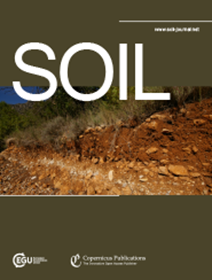以土壤多功能性为基准
IF 5.8
2区 农林科学
Q1 SOIL SCIENCE
引用次数: 0
摘要
摘要健康的土壤具有多种功能,对人类福祉有重要贡献,包括初级生产、气候和水调节以及支持生物多样性。这些功能可以部分地结合在一起,有些功能还可以明显地进行权衡:这就是土壤多功能性研究的动机。社会需要科学家帮助评估哪些土壤最适合发挥哪些土壤功能,并决定对任何特定土壤进行适当的长期管理,以实现最佳功能。然而,对于这两项任务,科学界都缺乏统一的工具,因此我在本文中提出了前进的方向。最关键的是,我们缺乏一个共同的测量框架,将土壤功能的测量固定在一个共同的尺度上。目前,该领域在测量和评估土壤功能及其指标的方法上存在分歧。在 65 个旨在测量土壤健康或质量的计划中,只有三个指标变量(SOM、酸度和可利用磷)得到了普遍测量(70% 的计划),而在 65 个计划中,没有超过 30% 的计划采用生物测量方法。这种现状阻碍了我们对不同土壤和土壤内部进行系统比较;我们缺乏一个土壤多功能性基准。我们可以通过建立一个共同的测量系统来系统地解决这一局限性。为此,我建议在一套通用的功能衡量标准的基础上,使用潜变量建模法来开发一套通用的 "土壤智商测试"。我将土壤功能视为潜变量,因为它们是无法直接测量的复杂过程,我们只能检测这些复杂过程的驱动因素和结果。潜变量模型在社会、经济和心理测量领域有着悠久的历史,被称为因子分析。因子分析的目的是通过将可测量的反应变量在一个共同的尺度上联系起来,从而得出假设构造的共同描述符--因子。在此,我将解释为什么需要采用这种新方法来研究土壤多功能性和土壤健康,以及如何将其操作化。这里提出的框架只是一个初步建议,土壤多功能性问题过于复杂和重要,不可能一蹴而就。这个问题需要科学家们共同努力,反复解决。我们需要汇聚最优秀的科学力量,通力合作,逐步完善可持续管理人类最宝贵资源之一--土壤--的方法。本文章由计算机程序翻译,如有差异,请以英文原文为准。
Benchmarking soil multifunctionality
Abstract. Healthy soils provide multiple functions that importantly contribute to human wellbeing, including primary production, climate and water regulation, and supporting biodiversity. These functions can partially be combined and some functions also clearly trade-off: this motivates soil multifunctionality research. Society needs scientists to help assess which soils are best for which soil functions and to determine appropriate long-term management of any given soil for optimal function delivery. However, for both tasks science lacks coherent tools and in this paper I propose a way forward. Critically, we lack a common measurement framework that pins soil functioning measurements on a common scale. Currently the field is divided with respect to the methods we use to measure and assess soil functioning and indicators thereof. Only three indicator variables (SOM, acidity, and available P) were commonly measured (>70 % of schemes) across 65 schemes that aim to measure soil health or quality, and no biological measure is implemented in more than 30 % of the 65 schemes. This status quo prevents us from systematically comparing across and within soils; we lack a soil multifunctionality benchmark. We can address this limitations systematically by setting a common measurement system. To do this, I propose to use latent variable modelling based on a common set of functional measurements, to develop a common ‘IQ test for soils’. I treat soil functions as latent variables, because they are complex processes that cannot be measured directly, we can only detect drivers and consequences of these complex processes. Latent variable modelling has a long history in social, economic and psychometric fields, where it is known as factor analysis. Factor analysis aims to derive common descriptors – the factors – of hypothesized constructs by linking measurable response variables together on a common scale. Here, I explain why such a new approach to soil multifunctionality and soil health is needed and how it can be operationalized. The framework developed here is only an initial proposal, the issue of soil multifunctionality is too complex and too important to be addressed in one go. It needs to be resolved iteratively by bands of scientist working intensively together. We need to bring our best science together, in a collaborative effort, to develop progressively more refined ways of sustainably managing one of humanity’s most precious resources: our soils.
求助全文
通过发布文献求助,成功后即可免费获取论文全文。
去求助
来源期刊

Soil
Agricultural and Biological Sciences-Soil Science
CiteScore
10.80
自引率
2.90%
发文量
44
审稿时长
30 weeks
期刊介绍:
SOIL is an international scientific journal dedicated to the publication and discussion of high-quality research in the field of soil system sciences.
SOIL is at the interface between the atmosphere, lithosphere, hydrosphere, and biosphere. SOIL publishes scientific research that contributes to understanding the soil system and its interaction with humans and the entire Earth system. The scope of the journal includes all topics that fall within the study of soil science as a discipline, with an emphasis on studies that integrate soil science with other sciences (hydrology, agronomy, socio-economics, health sciences, atmospheric sciences, etc.).
 求助内容:
求助内容: 应助结果提醒方式:
应助结果提醒方式:


